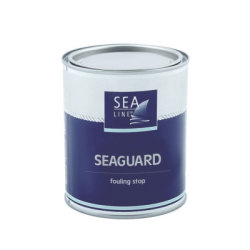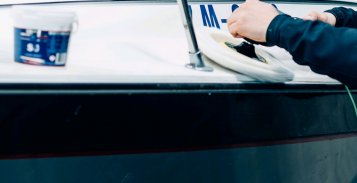
SEAGUARD FOULING STOP – a new anti-fouling paint for hulls.
Contrary to the traditional anti-fouling paints, SEAGUARD does not contain active ingredients, i.e. toxic biocides. The bottom paint is much more environmentally friendly, which is significant especially in the case of such reservoirs as lakes. It can also be used for fresh waters, coastal waters and salt waters. Modern solutions were applied in producing this paint which allowed to create a coating which will make it more difficult for lichens to maintain and develop on a surface. Sea-Line Seaguard works best for units moving with the speed not higher than of 30 knots and which are used often.
SEAGUARD is a self-polishing paint which is an extra benefit for users. It can be used for all types of yachts and boats – laminate, wood, steel and aluminium. It is available in 0,75 l and 2,5 l containers, navy blue and white colours. SEAGUARD is a paint which can safely be applied with air spraying and its advantage is high capability – up to 10m2 out of 1 litre.
The product was designed in view of the countries where anti-fouling varnishes containing biocides are forbidden and recalled. SEAGUARD FOULING STOP is compatible with the majority of available anti-fouling products and will be available from 10th March 2016.

Συγγνώμη,αυτή η εγγραφή είναι διαθέσιμη μόνο στα Πολωνικά.

Come and join us at METSTRADE 2023, METSTRADE the best event for marine industry professionals, happening from November 15th to […]

Visit us and our production plant without traveling

New in the 2023 season is a new polishing wool The new black and white polishing pads in premium quality […]
There is a possibility of thinning antifouling, but we do not recommend this procedure due to the risk of reducing the effectiveness of the paint. If it is necessary to thin the antifouling paint, it is recommended to dilute it to a maximum of 0-5% (by volume).

Επαναπλήρωση και για να αντιμετωπιστούν οι ανισότητες που προκαλούνται από ζημιές ή κατά τη διάρκεια της παραγωγής

Συγγνώμη,αυτή η εγγραφή είναι διαθέσιμη μόνο στα Πολωνικά, Αγγλικά Αμερικής, Γερμανικά, Γαλλικά, Ισπανικά Ευρώπης, Ιταλικά, Βουλγαρικά και Ρωσικά.

Παρέχει μια αισθητική και μία τέλειαόψητου σκάφους επίσης προστασία έναντι του νερού και uv ακτινοβολίας

Προστατεύει το σκάφος από την θαλάσσια ρύπανση , μαλακή και σκληρή

Αποτελεσματικάαφαιρείτις γρατσουνιές, ανανεώνει την απόχρωση του gelcoat ή του χρώματος, με επίπτωση γρήγορης λάμψης

Ειδική προετοιμασία για τον αποτελεσματικό καθαρισμό και φινίρισμα

Πλαστικοποίησης, κόλληση και συμπληρώνοντας ρωγμές στο gelcoat

Ποικιλία προϊόντων που είναι χρήσιμαστις εργασίες κατασκευής σκαφών